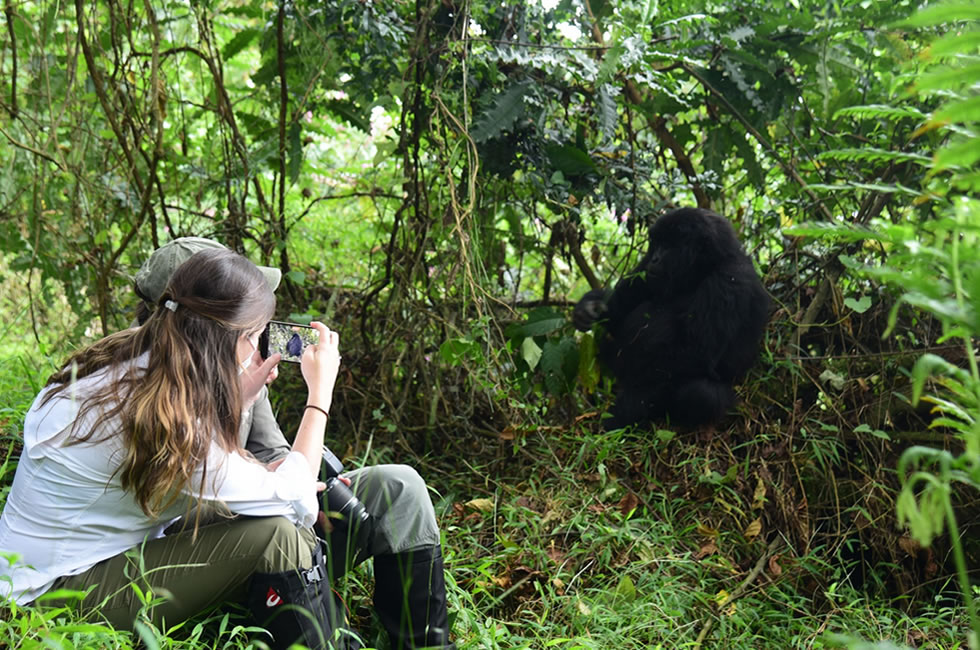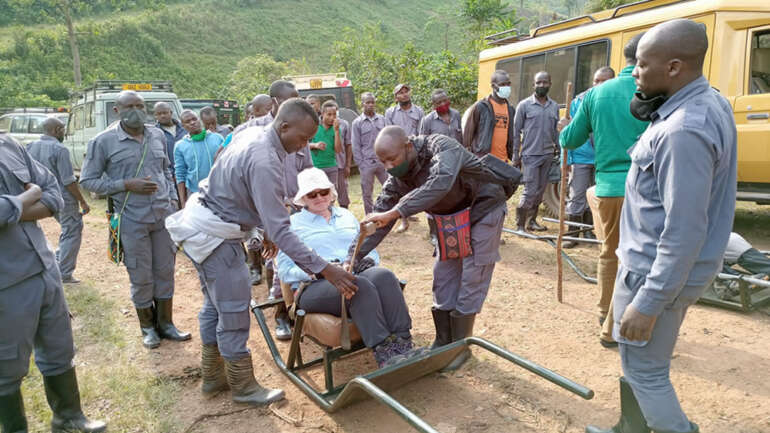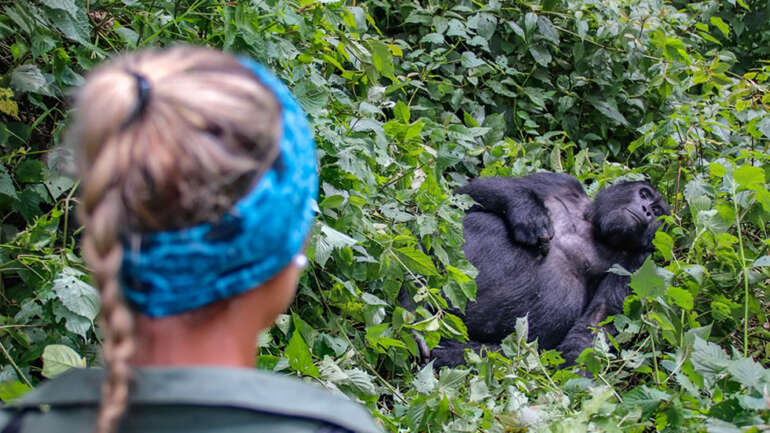Gorilla trekking is among the most physically demanding wildlife experiences. It requires navigating challenging terrain, enduring varying weather conditions, and maintaining patience as expert guides track gorilla families deep in the forests of Rwanda, Uganda, and the Democratic Republic of Congo (DR Congo).
Visitors considering the gorilla trekking experience often wonder about the level of difficulty involved. The answer is not straightforward, as multiple factors determine how challenging a trek will be. Variables such as the specific national park, altitude, vegetation density, and weather all shape the overall experience. Some treks conclude within an hour, while others extend well beyond five hours, requiring sustained physical effort.
This article provides a comprehensive analysis of the challenges associated with gorilla trekking. It examines the physical requirements, environmental conditions, and country-specific trekking conditions in Rwanda, Uganda, and Congo. Those planning a trip will gain valuable insights into preparation strategies and practical measures to enhance the experience while ensuring they are physically and mentally ready for the trek.
Factors That Make Gorilla Trekking Challenging
Terrain and Trail Conditions
Gorilla trekking takes place in mountainous and forested environments with limited infrastructure. The trails are not well-defined paths but routes that guide cut through thick undergrowth using machetes. These trails are often uneven, muddy, and obstructed by vines, roots, and fallen logs.
In Rwanda’s Volcanoes National Park, the terrain consists of volcanic slopes, which can be steep and physically taxing. The ascent is often rapid, requiring sustained effort over short distances. In contrast, Uganda’s Bwindi Impenetrable Forest presents a different challenge. The trails here are more unpredictable, with frequent inclines and declines. Bwindi is characterized by thick foliage, making navigation more strenuous. The DR Congo’s Virunga Park features similarly demanding trails, with steep gradients and wet, unstable ground contributing to the challenge.
Hikers must be prepared for variable footing, where loose soil, wet clay, and rocky sections demand careful balance and stability. Trekking poles can provide additional support, but physical endurance remains the key determinant of how well one copes with these conditions.
Altitude and Elevation Challenges
The elevation at which gorilla trekking occurs adds another layer of difficulty. In Rwanda, Volcanoes National Park sits at an altitude ranging from 2,400 to 4,507 meters (7,874 to 14,787 feet) above sea level. At these elevations, oxygen levels are lower, making physical exertion feel more intense. Some trekkers experience mild symptoms of altitude sickness, including shortness of breath, headaches, and dizziness.
Bwindi Impenetrable Forest in Uganda has a lower elevation range, between 1,160 and 2,607 meters (3,806 to 8,553 feet), but the undulating terrain increases exertion levels. Virunga National Park in Congo, situated between 2,200 and 4,500 meters (7,218 to 14,764 feet), presents similar altitude-related challenges as Rwanda.
Acclimatisation is advisable for those unaccustomed to high-altitude trekking. Spending a day at moderate elevations before the trek can help the body adjust. Maintaining hydration and pacing oneself throughout the hike is critical in managing altitude-related strain.
Duration and Trekking Distance
The time required to locate a gorilla family varies significantly, affecting the overall difficulty of the trek. Some groups are found within an hour, while others require five or more hours of continuous hiking before contact.
On average, gorilla treks last between two and six hours, including the return journey. The length of the trek depends on factors such as the movement of the gorillas, terrain conditions, and the group’s pace. Guides track the gorillas based on fresh footprints, droppings, and nests from the previous night, meaning the location is never fixed. If a group moves deeper into the forest or higher up the slopes, trekkers must follow, often covering long distances on steep, slippery trails.
Weather Conditions and Their Impact
Tropical rainforest climates make weather an unpredictable factor in gorilla trekking. The regions where gorillas reside receive frequent rainfall, even during the dry season. Sudden downpours can turn trails into muddy, slick surfaces that are difficult to traverse.
In Rwanda and Uganda, the wettest months are March to May and September to November. However, even in the drier months, rain is still a possibility. The Democratic Republic of Congo experiences similar conditions, with high humidity levels contributing to physical exhaustion.
Rain and mist reduce visibility and increase the risk of slipping on steep paths. Waterproof hiking boots with firm grip, gaiters, and quick-dry clothing help mitigate the discomfort caused by wet conditions.
Physical Fitness and Endurance Required
Gorilla trekking is a physically demanding activity that requires stamina, leg strength, and cardiovascular endurance. The continuous uphill and downhill hiking, combined with high humidity, can be exhausting. Those who lead a sedentary lifestyle may find the trek significantly more complex than individuals accustomed to regular physical activity.
Visitors are advised to engage in preparatory fitness routines before their trip. Cardiovascular exercises such as hiking, running, or cycling improve endurance, while strength training focusing on leg muscles enhances stability on steep trails. Core strength is also beneficial for maintaining balance on uneven ground.
Although gorilla trekking does not require technical climbing skills, it does demand sustained effort over extended periods. Those who struggle with knee or back issues should consult a medical professional before attempting the trek. Hiring a porter to assist with carrying backpacks can reduce strain and allow hikers to conserve energy for the more challenging sections of the journey.
Comparing Gorilla Trekking in Rwanda, Uganda, and Congo
The difficulty level in gorilla trekking varies across Rwanda, Uganda, and the Democratic Republic of Congo due to differences in terrain, vegetation density, elevation, and trek duration. Each country offers a distinct experience, with some locations presenting steeper ascents and others requiring prolonged hikes through thick forests.
Rwanda (Volcanoes National Park)
Rwanda’s Volcanoes National Park is known for its steep, volcanic terrain. The park lies at an elevation of 2,400 to 4,507 meters (7,874 to 14,787 feet), making it one of the highest-altitude gorilla trekking destinations. The trek often involves climbing narrow trails on the slopes of dormant volcanoes, which can be physically demanding, especially for those unaccustomed to high-altitude hiking.
The advantage of trekking in Rwanda is that the distances are shorter than in Uganda. Many gorilla families live within a two- to four-hour hike from the starting point, reducing the likelihood of prolonged treks. However, the incline can be strenuous, and the ground conditions vary depending on rainfall.
Another notable factor in Rwanda is the relatively open bamboo forest, which provides better visibility than Uganda’s dense undergrowth. This allows for clearer views of the gorillas once they are located, but it does not necessarily make the trek easier, as the steep paths and altitude remain a challenge.
Uganda (Bwindi Impenetrable Forest & Mgahinga National Park)
Uganda offers two gorilla trekking locations: Bwindi Impenetrable Forest and Mgahinga National Park. Bwindi, the more popular option, is known for its rugged, uneven terrain and thick forest cover, significantly increasing the trek’s difficulty. The trails are less predictable than those in Rwanda, featuring frequent ascents and descents through tangled vegetation.
Bwindi’s elevation ranges from 1,160 to 2,607 meters (3,806 to 8,553 feet), which is lower than Volcanoes National Park in Rwanda, but the trek itself can be longer. Depending on their movement, some groups require up to six hours of hiking to locate the gorillas. The combination of steep inclines, slippery trails, and thick foliage makes the trek in Bwindi particularly challenging.
Mgahinga National Park, Uganda’s smaller gorilla trekking destination, shares volcanic terrain similar to Rwanda’s Volcanoes National Park. The hikes here are steep but relatively shorter, offering a different experience from Bwindi’s more unpredictable forest routes.
Congo (Virunga National Park)
Virunga National Park in the Democratic Republic of Congo offers a more rugged trekking experience. The terrain consists of steep volcanic slopes and thick forests, similar to those in Rwanda and Uganda. The elevation ranges from 2,200 to 4,500 meters (7,218 to 14,764 feet), meaning the effects of altitude can be felt, particularly on longer treks.
One of the distinguishing factors of trekking in Virunga is the relatively low visitor numbers, which provides a more exclusive experience. However, the conditions can be physically demanding, with long hikes to reach some gorilla families. The trails can be unstable due to volcanic activity, and the rainforest climate means that rain is frequent, creating muddy and slippery paths.
Security is another consideration in Virunga, as the region has experienced periodic instability. To ensure safety, visitors should check current conditions before booking a trek.
| Factor | Rwanda | Uganda | Congo |
| Terrain | Steep volcanic slopes | Uneven, unpredictable forest terrain | A mix of steep slopes and thick forest |
| Elevation | 2,400 – 4,507 meters | 1,160 – 2,607 meters | 2,200 – 4,500 meters |
| Trail Conditions | Open bamboo forests, slippery ground | Thick vegetation, narrow and muddy trails | Unstable trails, volcanic soil |
| Trek Duration | 2 to 4 hours on average | 3 to 6 hours on average | 2 to 5 hours on average |
| Visibility | Better due to open bamboo forests | Limited due to dense foliage | Moderate visibility varies by location |
| Weather Impact | Frequent rain, muddy trails | High humidity, unpredictable rain | Heavy rainfall, slippery conditions |
| Trek Difficulty | Challenging due to steepness and altitude | Very challenging due to the terrain and length | Challenging, with additional security concerns |
How to Prepare for Gorilla Trekking
Gorilla trekking requires sustained physical effort, particularly for those assigned to groups located deep in the forest. Strength, endurance, and balance are key components of physical readiness.
- Cardiovascular Fitness: Hiking, running, cycling, or stair climbing help build stamina.
- Leg and Core Strength: Squats, lunges, and step-ups improve leg endurance, while core exercises such as planks and stability drills enhance balance on rough trails.
- Flexibility & Joint Mobility: Stretching exercises, yoga, and mobility drills help maintain joint flexibility and reduce stiffness during the hike.
- Altitude Acclimatization: For those unfamiliar with high-altitude environments, spending time at moderate elevations before the trek helps the body adjust to lower oxygen levels.
What to Pack for a Comfortable Trek
- Hiking Boots
- Lightweight, Quick-Dry Clothing
- Gloves
- Gaiters
- Daypack with Rain Cover
- Trekking Poles
- Water & Hydration Packs
- High-Energy Snacks


